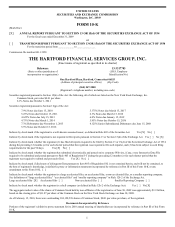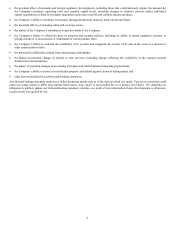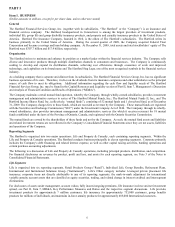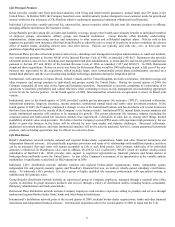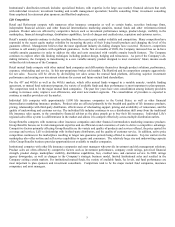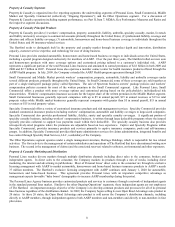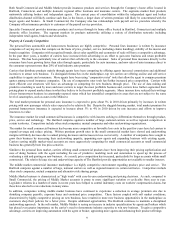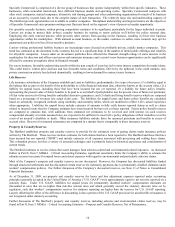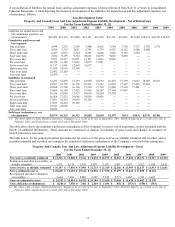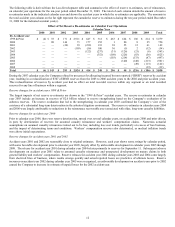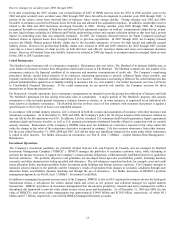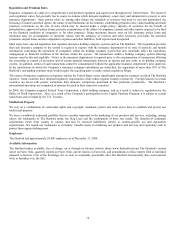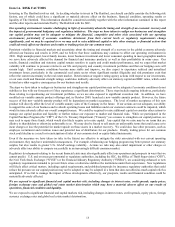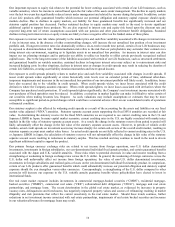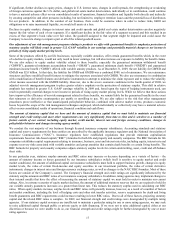The Hartford 2009 Annual Report Download - page 7
Download and view the complete annual report
Please find page 7 of the 2009 The Hartford annual report below. You can navigate through the pages in the report by either clicking on the pages listed below, or by using the keyword search tool below to find specific information within the annual report. 7
Institutional’ s distribution network includes: specialized brokers, with expertise in the large case market; financial advisors that work
with individual investors; investment banking and wealth management specialists; benefits consulting firms; investment consulting
firms employed by retirement plan sponsors; and Hartford employees.
Life Competition
Retail and Retirement compete with numerous other insurance companies as well as certain banks, securities brokerage firms,
independent financial advisors and other financial intermediaries marketing annuities, mutual funds and other retirement-oriented
products. Product sales are affected by competitive factors such as investment performance ratings, product design, visibility in the
marketplace, financial strength ratings, distribution capabilities, levels of charges and credited rates, reputation and customer service.
Retail’ s annuity deposits continue to decline resulting from the recent equity market volatility and competition. Many competitors have
responded to the recent equity market volatility by increasing the price of their living benefit products and changing the level of the
guarantee offered. Management believes that the most significant industry de-risking changes have occurred. However, competitors
continue to sell annuity products with significant guarantees. In the first six months of 2009, the Company increased fees on in-force
variable annuity guarantees in order to address the risks and costs associated with variable annuity benefit features. The Company
continues to explore other risk limiting techniques including product design, hedging and reinsurance. As part of the Company’ s de-
risking initiative, the Company is transitioning to a new variable annuity product designed to meet customers’ future income needs
within the risk tolerances of the Company.
Retail mutual funds compete with other mutual fund companies and differentiate themselves through product solutions, performance,
expenses, wholesaling and service. In this non-proprietary broker sold market, The Hartford and its competitors compete aggressively
for net sales. Success will be driven by diversifying net sales across the mutual fund platform, delivering superior investment
performance and creating new investment solutions for current and future mutual fund shareholders.
For the 457 and 403(b) as well as the 401(k) markets, which offer mutual funds wrapped in a variable annuity, variable funding
agreement, or mutual fund retirement program, the variety of available funds and their performance is most important to plan sponsors.
The competitors tend to be the major mutual fund companies. The past few years have seen consolidation among industry providers
seeking to increase scale, improve cost efficiencies, and enter new market segments. The consolidation of providers is expected to
continue as smaller providers exit the market.
Individual Life competes with approximately 1,000 life insurance companies in the United States, as well as other financial
intermediaries marketing insurance products. Product sales are affected primarily by the breadth and quality of life insurance products,
pricing, relationships with third-party distributors, effectiveness of wholesaling support, pricing and availability of reinsurance, and the
quality of underwriting and customer service. The individual life industry continues to see a distribution shift away from the traditional
life insurance sales agents, to the consultative financial advisor as the place people go to buy their life insurance. Individual Life’ s
regional sales office system is a differentiator in the market and allows it to compete effectively across multiple distribution outlets.
Group Benefits competes with numerous other insurance companies and other financial intermediaries marketing insurance products.
Group Benefits focuses on its risk management expertise and on efficiencies and economies of scale to derive a competitive advantage.
Competitive factors primarily affecting Group Benefits are the variety and quality of products and services offered, the price quoted for
coverage and services, Life’ s relationships with its third-party distributors, and the quality of customer service. In addition, active price
competition continues in the marketplace resulting in longer rate guarantee periods being offered to customers. Top tier carriers in the
marketplace also offer on-line and self service capabilities to agents and consumers. The relatively large size and underwriting capacity
of the Group Benefits business provides opportunities not available to smaller companies.
Institutional competes with other life insurance companies and asset managers who provide investment and risk management solutions.
Product sales are often affected by competitive factors such as investment performance, company credit ratings, perceived financial
strength, product design, marketplace visibility, distribution capabilities, fees, credited rates, and customer service. In 2009, ratings
agency downgrades, as well as changes in the Company’ s strategic business model, limited Institutional sales and resulted in the
Company exiting certain markets. For institutional mutual funds, the variety of available funds, fee levels, and fund performance are
most important to plan sponsors and investment consultants. Competitors tend to be the major mutual fund companies, insurance
companies, and asset managers.

